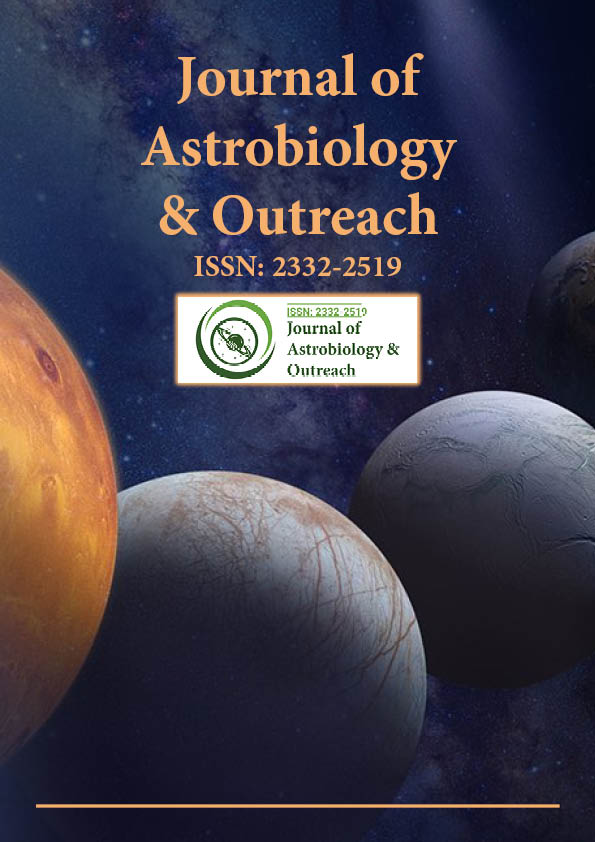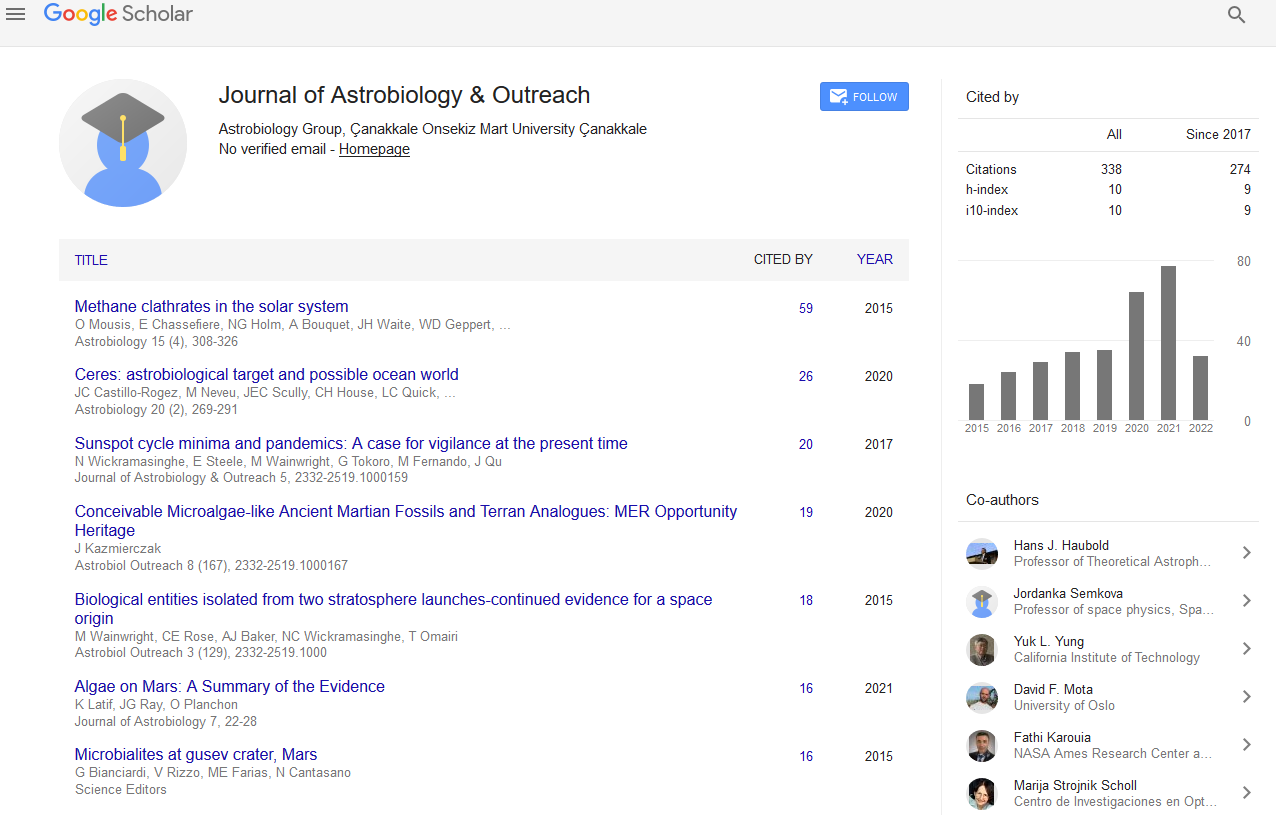Indexed In
- Open J Gate
- Academic Keys
- JournalTOCs
- RefSeek
- Hamdard University
- EBSCO A-Z
- OCLC- WorldCat
- Google Scholar
Useful Links
Share This Page
Journal Flyer

Open Access Journals
- Agri and Aquaculture
- Biochemistry
- Bioinformatics & Systems Biology
- Business & Management
- Chemistry
- Clinical Sciences
- Engineering
- Food & Nutrition
- General Science
- Genetics & Molecular Biology
- Immunology & Microbiology
- Medical Sciences
- Neuroscience & Psychology
- Nursing & Health Care
- Pharmaceutical Sciences
Commentary - (2025) Volume 13, Issue 2
Radio Astronomy's Time Capsule: Tracing the Historical Footprints of Cosmic Discoveries
Samen Ali*Received: 16-Dec-2023, Manuscript No. JAO-23-24462; Editor assigned: 19-Dec-2023, Pre QC No. JAO-23-24462; Reviewed: 02-Jan-2025, QC No. JAO-23-24462; Revised: 22-Jan-2025, Manuscript No. JAO-23-24462; Published: 29-Jan-2025, DOI: 10.35248/2332-2519.25.13.377
Description
Radio astronomy, a branch of astrophysics that observes celestial objects through radio waves, has revolutionized our understanding of the universe. Different traditional optical telescopes, which detect visible light, radio telescopes capture signals in the radio frequency range. This innovative approach has unveiled a cosmos teeming with mysteries, from distant galaxies to enigmatic cosmic phenomena.
Historical perspective
The roots of radio astronomy can be traced back to the accidental discovery of cosmic radio waves by Karl Jansky in 1932. Jansky, an engineer at Bell labs, was investigating sources of interference in transatlantic radio communications when he stumbled upon radio emissions from the Milky Way. This serendipitous finding covered the method for further exploration into the radio frequency domain, marking the biological of a different era in astronomy.
Development of radio telescopes
The first practical application of radio astronomy came with the construction of the radio telescope by Grote Reber in 1937. Reber's pioneering work laid the foundation for the development of more sophisticated radio telescopes. The Jodrell Bank observatory in the United Kingdom, home to the iconic Lovell telescope, became a pivotal hub for early radio astronomical research. Subsequently, advancements in technology led to the creation of radio interferometers, arrays of telescopes working together to enhance sensitivity and resolution.
Probing the cosmic landscape
One of the advantages of radio astronomy is its ability to penetrate cosmic dust and gas clouds, providing a clearer view of objects that are obscured in the optical spectrum. Radio waves also reveal unique phenomena, such as pulsars and quasars, which emit strong radio signals. Pulsars, discovered in 1967 by Jocelyn Bell Burnell, are rapidly rotating neutron stars that emit beams of radiation, resembling the rhythmic beats of a cosmic lighthouse. Quasars, on the other hand, are extremely bright and energetic sources, often associated with supermassive black holes at the centers of distant galaxies.
Mapping the universe
Radio astronomy has played a vital role in mapping the largescale structure of the universe. The Cosmic Microwave Background (CMB), a remnant radiation from the early universe, was first detected using radio telescopes. This discovery provided invaluable insights into the origin and evolution of the cosmos. Additionally, radio surveys, such as the Very Large Array (VLA) sky survey, have mapped vast regions of the sky, uncovering a wealth of information about the distribution of galaxies and the cosmic web.
Interstellar chemistry and astrobiology
Radio astronomy has proven instrumental in studying the chemistry of interstellar space. Molecules, such as complex organic compounds, emit distinctive radio frequencies that can be detected by radio telescopes. Observations of interstellar molecular clouds have revealed the building blocks of life, hinting at the possibility of extraterrestrial life. This intersection of radio astronomy with astrobiology fuels our quest to understand the potential for life beyond Earth.
Advancements in technology
Over the times, radio astronomy has observed remarkable technological advancements. The Atacama Large Millimeter/ Submillimeter Array (ALMA), located in the high-altitude desert of Chile, represents a facility that combines the power of multiple radio antennas to achieve unprecedented resolution. The Square Kilometer Array (SKA), an international project under development, aims to create the world's largest and most sensitive radio telescope, opening new frontiers in exploration of the universe.
Challenges and future prospects
Despite its successes, radio astronomy faces tests such as radio frequency interference from human-made sources. Efforts to mitigate this interference and protect radio-quiet zones are essential for the continued progress of radio astronomical research. Looking ahead, the field holds immense potential for discoveries in areas like dark matter, gravitational waves, and the elusive nature of cosmic magnetism.
Conclusion
Radio astronomy stands as a testament to human curiosity and technological ingenuity, offering a unique perspective on the cosmos. From unraveling the mysteries of pulsars to mapping the cosmic microwave background, radio telescopes continue to expand our understanding of the universe's vast tapestry. As technology advances and new facilities come online, the future of radio astronomy potentials to show even more secrets, inspiring generations to come in their exploration of the celestial wonders that grace our night sky.
Citation: Ali S (2025) Radio Astronomy's Time Capsule: Tracing the Historical Footprints of Cosmic Discoveries. J Astrobiol Outreach. 13:377.
Copyright: © 2025 Ali S. This is an open-access article distributed under the terms of the Creative Commons Attribution License, which permits unrestricted use, distribution, and reproduction in any medium, provided the original author and source are credited.

